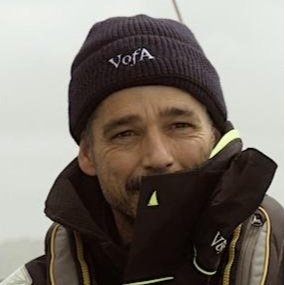Islands that "grow" on you.
Vinson anchored at Carcass Island
Our guide on board, Giselle, was right to the point when she told us New Year Cove in Weddle Island is a bulletproof anchorage. We are hiding from the last big Southwesterlies blow. It's the first time Vinson cruises around the archipelago. We left Stanley about ten days ago to experience and learn about the West Falklands. They are a remote place that remains almost intact. Hundreds of islands and islets within the same land extension as the Balearic Islands have a population of just over a hundred persons. However, while the Balearics has a population of a million persons; here the population is composed of the breeding species, Albatrosses, Gentoo, Rockhopper and Jackass penguins, Commerson dolphins, Killer and Sei Whales, Skuas, Prions, Petrels, Elephant and Fur seals, Sea lions and more. Its rich wildlife and the hundreds of safe anchorages, tidal currents, and narrow passages make these distant waters a dream playground for sailors, divers, and birders.
A black browed albatross venturing from the clift at Carcass Island.
Wet landing at Ship Harbour, Pebble Island.
Dusk hour at Grey Cove
Just a hand full of islands are inhabited. Most of these have a small settlement where about two to ten people live. They are all private, so you will only land after seeking permission. Preparing your route and arriving at an anchorage is a pleasant courtesy game. You may get permission to go ashore as long as you show a sincere interest and respect towards the property you're about to walk in. On each of these islands, you'll probably meet the owners. They will have probably been living there for decades. They are very self-sufficient; they eat their beef and mutton, grow vegetables and milk their cows. You will even have the most fantastic homemade biscuits ever at tea time. They are baking artists.
Black browed albatrosses and Rockhopper penguin couples. Carcass Island
Black Browed albatrosses nests.
Thies and Kicki look after West Point Island. After circumnavigating the planet, they stayed in the Southern high latitudes. They showed us beautiful photos and amazing stories from when they stayed for two years in South Georgia! We also crossed some words with Rob McGill at Carcass Is. He had a cold, but his people immaculately treated us. At the Weddle settlement, Lewis Clifton walked me through all their facilities and the old sealers' shipyard and warehouse. Unfortunately, the strong winds kept us on board at Saunders Is. We could not meet the Pol-Evans. At Beaver Island we had the chance to sit and talk with the great polar sailor Jerome Poncet, who kindly walked us through his place and his boats Damien II and Golden Fleece.
Golden Fleece and Damien II in Beaver Island
During the next thirty-six hours, the gale conditions might ease, and we may sail back to civilization. We will soon set sail on a new expedition to Antarctic Convergence waters. We’ll be preparing it from Stanley, the natural gateway to South Georgia.
Antarctica, South Georgia, and Patagonia are magnanimous and shocking. They hook you from the first moment you see them; their beauty is evident and entirely visual. But instead, the Falklands' qualities are subtle and hidden. As a result, they are slower meals to digest. As Thies and Kikih told us, while Antarctica, South Georgia, and Patagonia catch you instantly, the Falkland Islands slowly "grow" on you.
Pictures by Kenneth Perdigón
Kenneth Perdigón
Skipper












